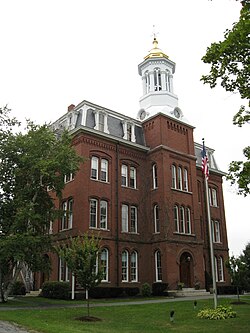Maine Wesleyan Seminary
| Kents Hill School | |
|---|---|
 |
|
| Location | |
|
Kents Hill, Maine 04349 United States |
|
| Coordinates | 44°24′16″N 70°00′08″W / 44.4045°N 70.0022°WCoordinates: 44°24′16″N 70°00′08″W / 44.4045°N 70.0022°W |
| Information | |
| Type | Private, Boarding |
| Motto | One man or woman of principle can always make a difference. |
| Religious affiliation(s) | Methodist |
| Established | 1824 |
| Headmaster | Christopher S. Cheney |
| Grades | 9–12, PG |
| Enrollment | 245 |
| Student to teacher ratio | 6:1 |
| Campus | Township, 400 acres (160 ha) |
| Mascot | Husky |
| Website | |
|
Kent's Hill School Historic District
|
|

Bearce Hall
|
|
| Area | 8 acres (3.2 ha) |
| Built | 1873 |
| Architect | Francis H. Fassett |
| Architectural style | Italianate, Queen Anne, Colonial Revival |
| NRHP Reference # | 79000149 |
| Added to NRHP | April 26, 1979 |
Kents Hill School (also known as Kents Hill or KHS) is a co-educational independent college-preparatory school for boarding and day students. Kents Hill is located in Kents Hill, Maine, 12 miles west of the state capital of Augusta. It is the 30th oldest boarding school in the United States and one of the oldest continuously operating co-educational college preparatory schools. One of the three oldest Methodist academies in the United States (with Cazenovia and Wilbraham), the school is now a member of the Association of Independent Schools in New England (AISNE) and accredited by the New England Association of Schools and Colleges (NEASC).
Kents Hill was founded in 1824 as the Maine Wesleyan Seminary by Luther Sampson, a Duxbury, Massachusetts native and a veteran of the American Revolution. According to an early publication of the Kents Hill Breeze, a defunct school periodical, Luther "was of the fifth generation in lineal descent from Henry Sampson, one of the Pilgrim band that landed on Plymouth Rock, December 22, 1620." A carpenter who had not had a formal education, Sampson wanted to use the wealth he had earned in his profession and the government-granted assignment of land he earned as a Colonial soldier to benefit society and to glorify God. Sampson, his wife Abigail Ford, and their children lived in Duxbury and, later, Marshfield, before relocating to over two hundred acres in Readfield, Maine, around the turn of the century. In 1821, Sampson incorporated there the "Readfield Religious and Charitable Society," whose original charter contained no mention of a school, but rather laid a plan to support area Methodist belief and practice. Sampson deeded the society over one hundred acres of land on Kents Hill.
Failing financially and seeking a more efficacious means of performing his mission, by 1823 Sampson had begun to explore the possibility of changing the society's identity into one rooted in the education of youths. Together with Elihu Robinson, a carpenter-schoolmaster in the nearby city of Augusta, and his wife, they opened the Seminary in order to better society through education. Boys and girls appeared on the school's roster from the day the school opened.
Later headmaster, Dr. Henry P. Torsey, oversaw the construction of Sampson Hall which was opened in 1860 and is still serving students today. Dr. Torsey also opened a female collegiate institute - the "Female College" - one of the first of its kind to offer degrees to women at the time. Dr. Torsey is also credited with introducing baseball to the school in 1861.
...
Wikipedia
